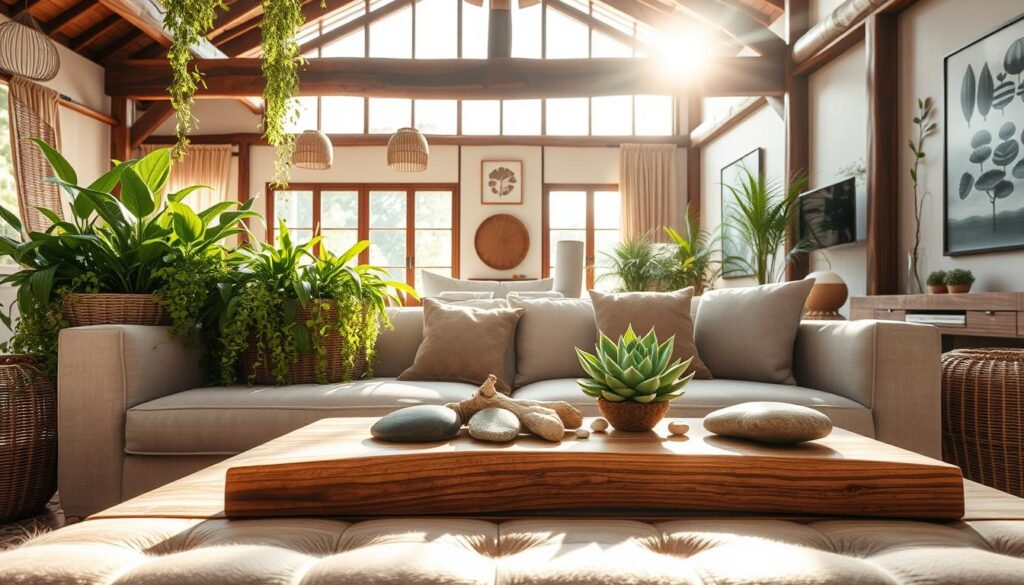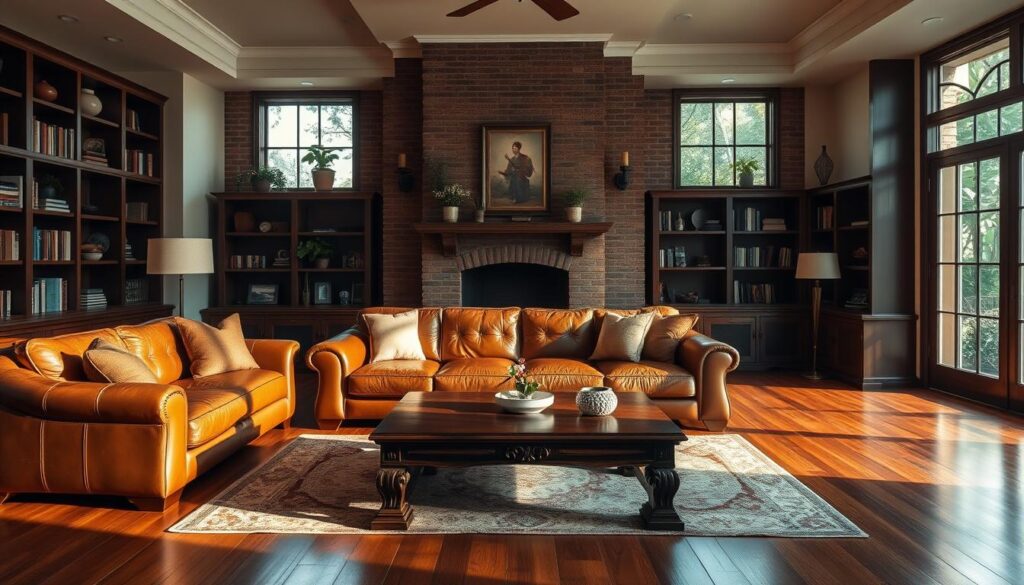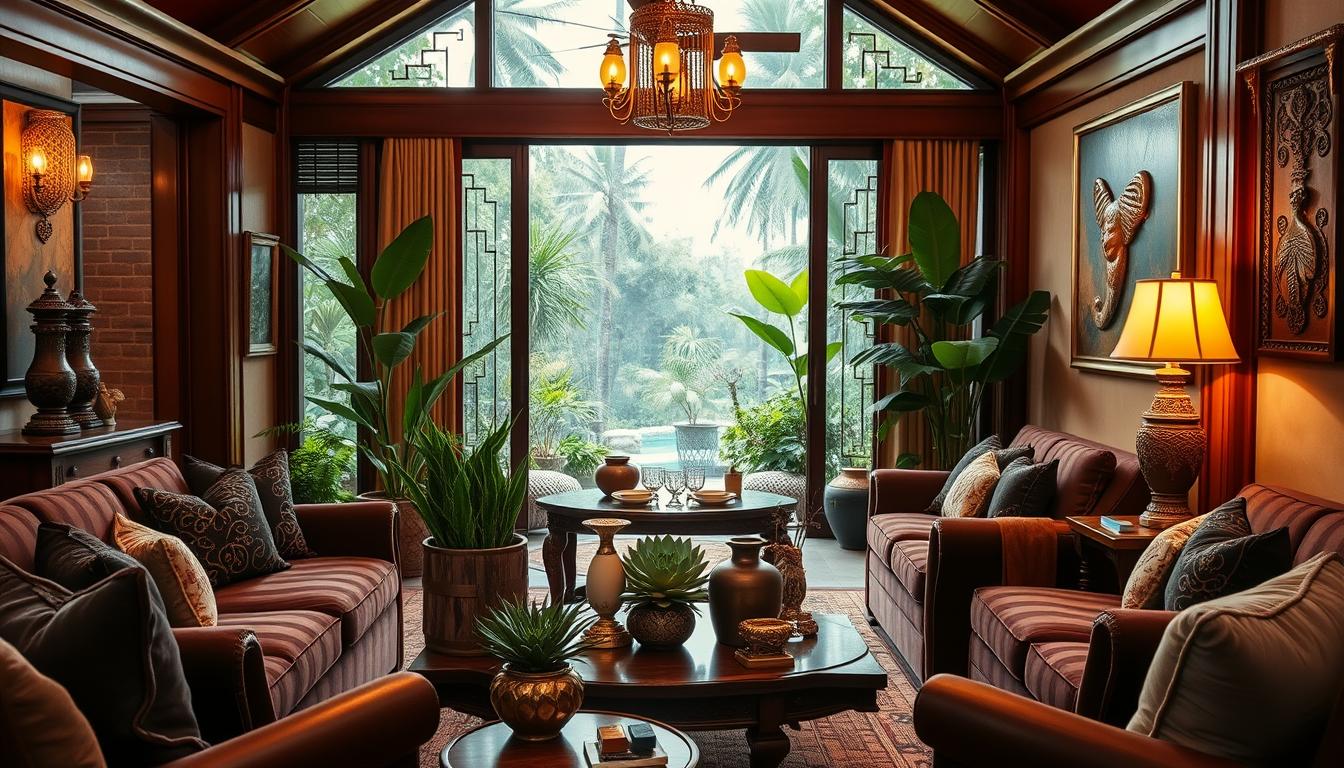Making a beautiful Java home interior is like creating a work of art. It’s about mixing function with beauty. With the right touches, your home can show off your style.
Whether you’re redoing your space or starting fresh, we’ve got you covered. Our guide will show you how to make a Java home decor that’s both beautiful and yours.
Key Takeaways
- Understand the basics of Java home interior design
- Learn how to incorporate natural elements into your decor
- Get practical tips for renovating or designing your Java home
- Discover how to balance functionality with aesthetic appeal
- Create a beautiful and unique living space
Understanding Java Home Interior Design
Java home interior design combines natural materials with cultural heritage. This mix makes Java-inspired homes stand out from others.
What Sets Java Home Interiors Apart?
Java home interiors focus on natural elements and traditional craftsmanship. They use reclaimed wood, intricate carvings, and earthy tones. This creates a warm, inviting atmosphere.
These elements add beauty and bring history and culture into the home. They make Java home interiors unique.
Key Characteristics of Java Style
Java style interior design is known for natural materials, vibrant colors, and intricate patterns. Homes often feature wooden furniture, stone decor, and textiles with traditional motifs.
| Element | Description | Example |
|---|---|---|
| Natural Materials | Use of wood, stone, and natural fibers | Reclaimed wood flooring |
| Vibrant Colors | Incorporation of earthy tones and rich hues | Terracotta-colored walls |
| Intricate Patterns | Use of traditional motifs in textiles and decor | Batik-patterned fabrics |
Knowing these characteristics helps homeowners create a Java-inspired interior. It’s both beautiful and culturally rich.
Essential Elements of Java Home Interiors
Java home decorating ideas focus on bringing nature inside. They use natural materials and earthy tones for a cozy feel. When designing a Java-inspired home, there are key elements to think about.
Furniture Choices
Choosing the right furniture is important. Use natural materials like wood, rattan, and wicker. These add warmth and authenticity to your space.
Look for pieces with intricate carvings or traditional Javanese designs. This enhances your home’s cultural heritage.
Color Palettes
For colors, go for earthy tones like green, brown, and beige. These colors remind you of Java’s landscapes and soil. They create a calming and natural feel in your home.
You can also add richer tones like terracotta and dark wood finishes. These add depth and character to your space.
Textures and Materials
Using different textures and materials makes your space interesting. Mix smooth surfaces like marble or polished wood with rougher textures like woven baskets or natural stone. This adds visual and tactile interest.
By choosing furniture, colors, and textures that reflect Java’s natural beauty and culture, you can create a modern Java home. It will feel authentic and welcoming.
Choosing the Right Layout for Your Space
The right layout can make your Java home look great and work well. It shows off the Java style. Designing a Java-inspired home means the layout is key. It affects how your home looks and works.
Open-concept layouts are popular for their flow and connection. Traditional layouts offer separation and definition. They’re good for areas like bedrooms or home offices.
Open Concept vs. Traditional Layouts
Modern Java homes often have open-concept layouts. They let living, dining, and kitchen areas flow together. This is great for entertaining or big families. But, it might lack privacy and defined spaces.
Traditional layouts have separate rooms and spaces. They’re good for quiet, private areas. But, they can make the home feel fragmented if not done right.
Choosing between open-concept and traditional layouts depends on your lifestyle and needs. For example, a traditional layout with a dedicated office is good for working from home. An open-concept layout is better for hosting gatherings.
Creating Flow in Your Home
Creating flow is key for a harmonious home. This means planning the placement of java home furniture and ensuring easy movement from one area to another.
- Use area rugs to define different spaces within an open-concept layout.
- Select furniture that is proportionate to the size of each room.
- Consider the traffic path through your home and arrange furniture to facilitate easy movement.
Adding natural java home interior design elements like wooden accents and plants can improve flow and look. By mixing layout, furniture, and natural elements, you can make a Java-inspired home that’s both beautiful and functional.
Incorporating Natural Elements
Natural elements are key in Java home design. We’ll see how to use them well. Wood, stone, and plants make your living space warm and inviting, connecting you to nature.
Using Wood and Stone in Decor
Wood and stone add warmth and texture to your home. Think about using reclaimed wood for furniture or floors. It brings history and character. Stone walls or fireplaces make great focal points.

“Natural materials like wood and stone make your home feel real,” says a top interior designer. “It’s about blending indoors and outdoors harmoniously.”
The Role of Plants and Greenery
Plants and greenery do more than decorate. They enhance your Java home’s natural feel. Add tropical elegance with lush plants like ferns, orchids, or peace lilies. Try a vertical garden or hanging planters to add beauty and save space.
- Choose plants that do well indoors.
- Use different plant sizes and textures for interest.
- Place plants where they get the right light.
By adding natural elements, you get a stylish, minimalist Java home. It looks great and makes you feel calm and well.
Lighting Options in Java Home Interiors
The right lighting can make a Java-style home feel welcoming. Lighting is key in Java home design, affecting both function and feel. Mixing natural and artificial light creates a rich, layered look.
Natural Lighting Techniques
Natural light is vital in Java home design. To get more natural light, try:
- Skylights to bring in light from above
- Large windows to let sunlight in
- Solar tubes to direct natural light inside
These methods cut down on artificial light needs. They also make spaces feel open and connected to nature.
Choosing Ambient and Task Lighting
Ambient and task lighting are also crucial for a cozy feel. Ambient lighting lights up the whole area. Task lighting shines on specific spots for tasks.
For ambient light, think about:
- Table lamps with soft shades
- Floor lamps for warmth and style
- String lights for a cozy feel
For task light, use:
- Desk lamps for reading and work
- Under-cabinet lights in kitchens
- LED strips for accenting
By mixing these lights, you can create a warm and inviting space in your Java home.
Java Home Interior Color Schemes
The right color palette can make your Java home renovation a stunning success. When picking a color scheme for your Java-inspired home, think about the natural beauty of Java.
Earthy tones like green, brown, and beige are great choices. They add warmth and coziness to your space. These colors remind us of Java’s lush landscapes, creating a calm atmosphere in your home.
Popular Color Combinations
Some top color combinations for a modern Java home interior include:
- Earth Tones and Vibrant Accents: Mix earthy tones like beige and brown with bright accents like red or orange. This adds a fun pop of color.
- Greenery and Neutrals: Pair different greens with neutral tones for a calming, natural feel.
- Warm and Cool Tones: Mix warm tones like terracotta with cool tones like blue for a balanced color scheme.

How to Test Colors Before Committing
It’s key to test colors in your home before making a final choice. Here are some tips:
- Paint Samples: Paint small wall sections with your chosen colors. See how they look at different times of the day.
- Color Boards: Make color boards with paint swatches or colored cards. This helps you see how colors work together.
- Digital Tools: Use digital tools or apps to see how colors will look in your space.
Testing colors before committing ensures your chosen scheme enhances your Java home’s interior. It also creates the ambiance you desire.
Accessorizing Your Java Home
Java home decor is all about making it your own with the right accessories. It shows how the right items can make a space truly special and show off your style.
Decorative Items that Enhance Style
There are many ways to add style to your Java-inspired home. Traditional Java textiles like batik and ikat bring in cultural flair. Adding wooden carvings and handmade crafts warms up the space, just like Java decor does.
Plants are also key in Java home decor. They add a natural touch, clean the air, and bring calm. Adding plants like orchids or ferns can make your Java home look even better.
The Importance of Personal Touches
Personal touches make a house feel like home. In Java decor, this means showing off family heirlooms or local artwork that speaks to you. This way, your space reflects Java’s beauty and your own story.
Accessorizing your Java home is about finding the right mix of cultural inspiration and personal flair. By choosing the right items and adding personal touches, you can make a space that’s both stunning and meaningful.
Sustainable Practices for Java Interiors
Exploring Java home interiors, we find the need for sustainable practices grows. Many aim to create homes that are both stunning and green. By adopting eco-friendly habits, we can lessen our impact on the environment while keeping our homes looking great.
Sourcing Eco-Friendly Materials
Using eco-friendly materials is vital for sustainable Java homes. Think about reclaimed wood, bamboo, and paints with low VOCs. These choices help the planet and make our homes healthier.
For a minimalist java home design, pick materials that are green and simple. This look is not only beautiful but also eco-friendly.
Energy-Efficient Design Tips
Energy efficiency is key in a green Java home. Use natural light, energy-saving appliances, and smart home design. These steps cut down on the need for artificial lights and heating/cooling.
- Maximize natural light by using sheer curtains or blinds.
- Install energy-efficient LED lighting.
- Use smart home devices to monitor and control energy usage.
By adding these green practices to our Java homes, we help the planet and make our living spaces better. Embracing sustainability leads to a greener lifestyle, fitting the natural java home interior ideal.
Budgeting for Java Home Interior Projects
Starting a Java home interior project means setting a budget first. A good budget is key to a successful renovation. It helps you reach your design goals without overspending.
Setting Realistic Renovation Budgets
Begin by checking your finances to see how much you can spend. Think about your income, savings, and any loans you might take. It’s also important to decide what to spend on first.
Prioritization is key when budgeting for your Java home interior. Focus on the things that will make your space look and feel better. This might include choosing the right java home color schemes that show off Java style.
Tips for Cost-Effective Upgrades
To save money, look for affordable design ideas that still look great. Buying materials locally can cut costs and support local artists. Also, think about using old furniture or decor in new ways. This can be a budget-friendly way to keep your java home interior design intact.
“The way you furnish and decorate your home reflects your personality and style, and with a little creativity, you can achieve a beautiful Java home interior without breaking the bank.”
By keeping an eye on your budget and looking for ways to save, you can create a beautiful Java home interior. It will be both stylish and practical.
Maintenance Tips for Java Home Interiors
To keep your Java home interiors looking great, regular maintenance is key. A well-kept home stays beautiful and makes materials last longer.
Keeping Your Home’s Look Fresh
Keeping your Java-inspired home looking fresh is important. Dust and polish furniture, like wood pieces, often. Our article on wooden furniture benefits can help.
Set a routine for weekly dusting and monthly polishing. For detailed wooden designs, use a soft cloth and gentle polish. This keeps the wood shiny.
Easy Cleaning Solutions
Cleaning your Java home interiors is easy with the right products. Use pH-neutral cleaners on wood and stone to avoid damage. For daily cleaning, mix water with mild soap for most surfaces.
| Surface Type | Recommended Cleaner | Cleaning Frequency |
|---|---|---|
| Wooden Furniture | Gentle wood polish | Monthly |
| Stone Surfaces | pH-neutral stone cleaner | Weekly |
| Textiles (upholstery, curtains) | Mild detergent | As needed |
By following these tips, your Java home interiors will stay beautiful and welcoming. Regular care keeps your home looking good and lasts longer.
Final Thoughts on Crafting Java Home Interiors
As we finish our Java-inspired home, remember to add your personal touch. This makes your home not just beautiful but truly yours. It’s all about showing off your style and comfort.
Personalizing Your Space
To make your home modern and Java-inspired, pick decorating ideas that speak to you. Think about unique pieces, bright colors, or natural textures. These add warmth and character to your space.
Staying Ahead of Trends
Looking ahead, keep up with the latest in Java home design. This keeps your home a true reflection of you. By trying new ideas, your home will always feel fresh and exciting.


